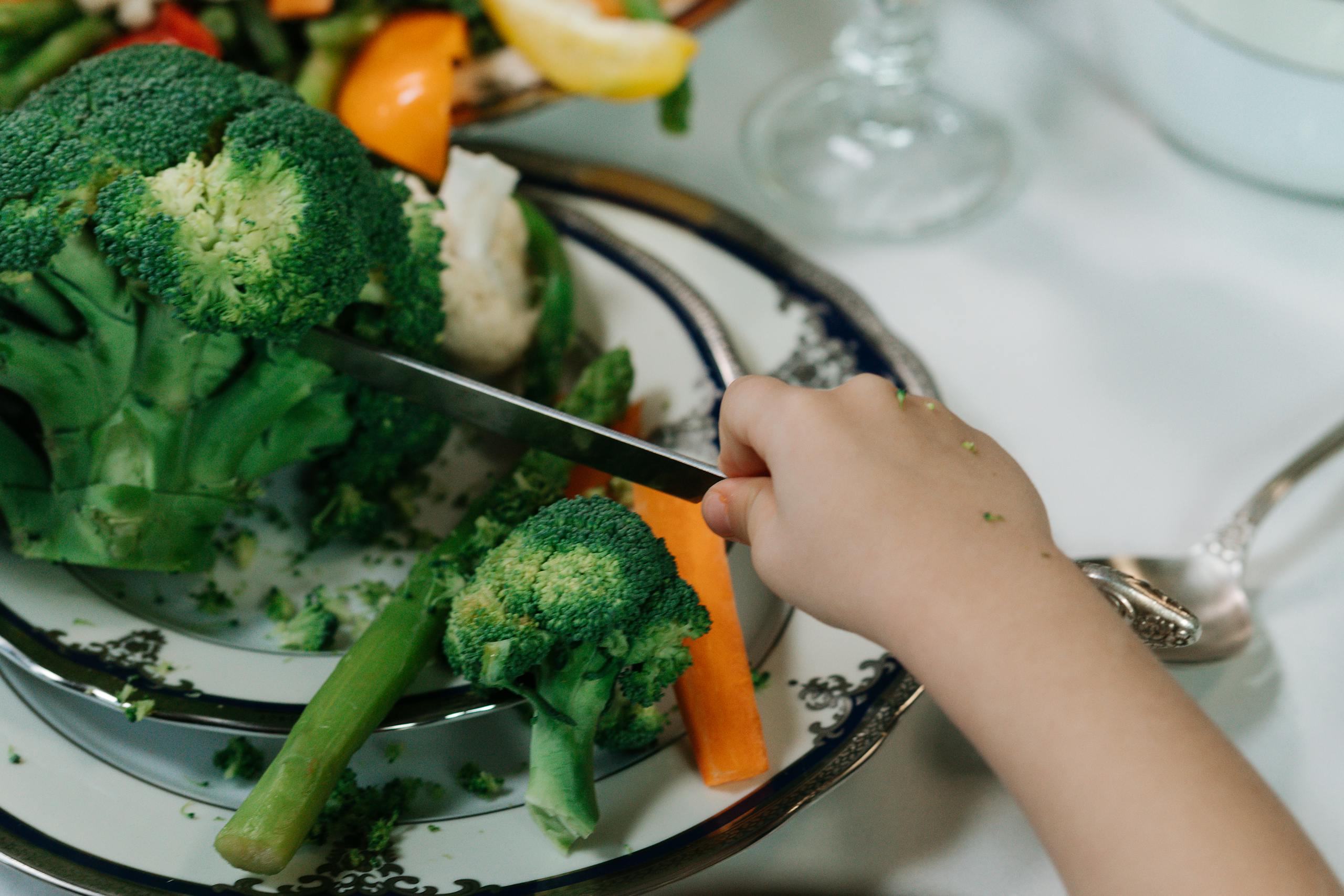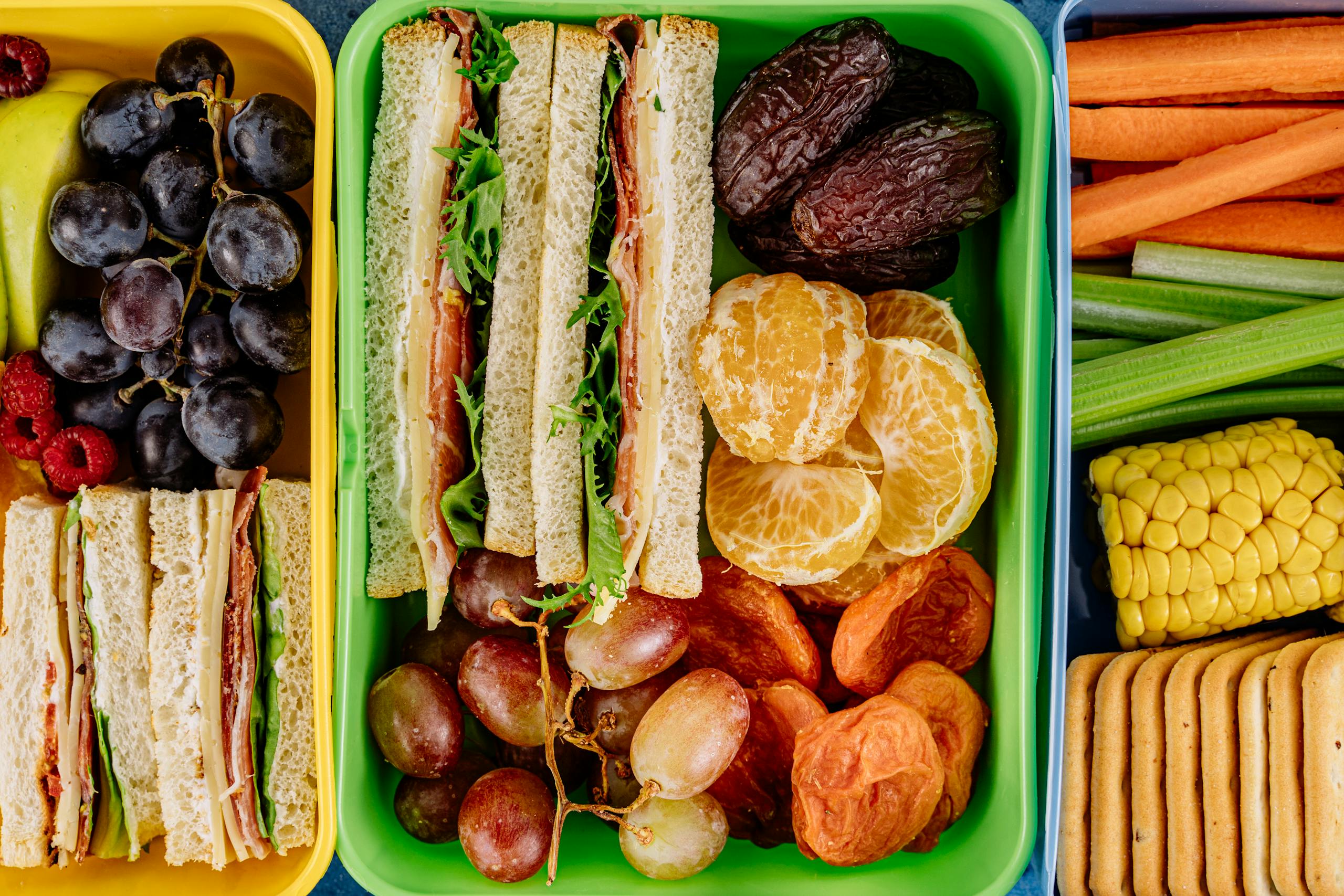Starting Solids 101: FAQ’s I Get Asked As a Pediatrician
This post features the 20 most common questions I get asked as a pediatrician about how to start babies on solids. I talk about signs that your baby is ready, the best first foods, how much to feed, how to avoid choking, and so much more!
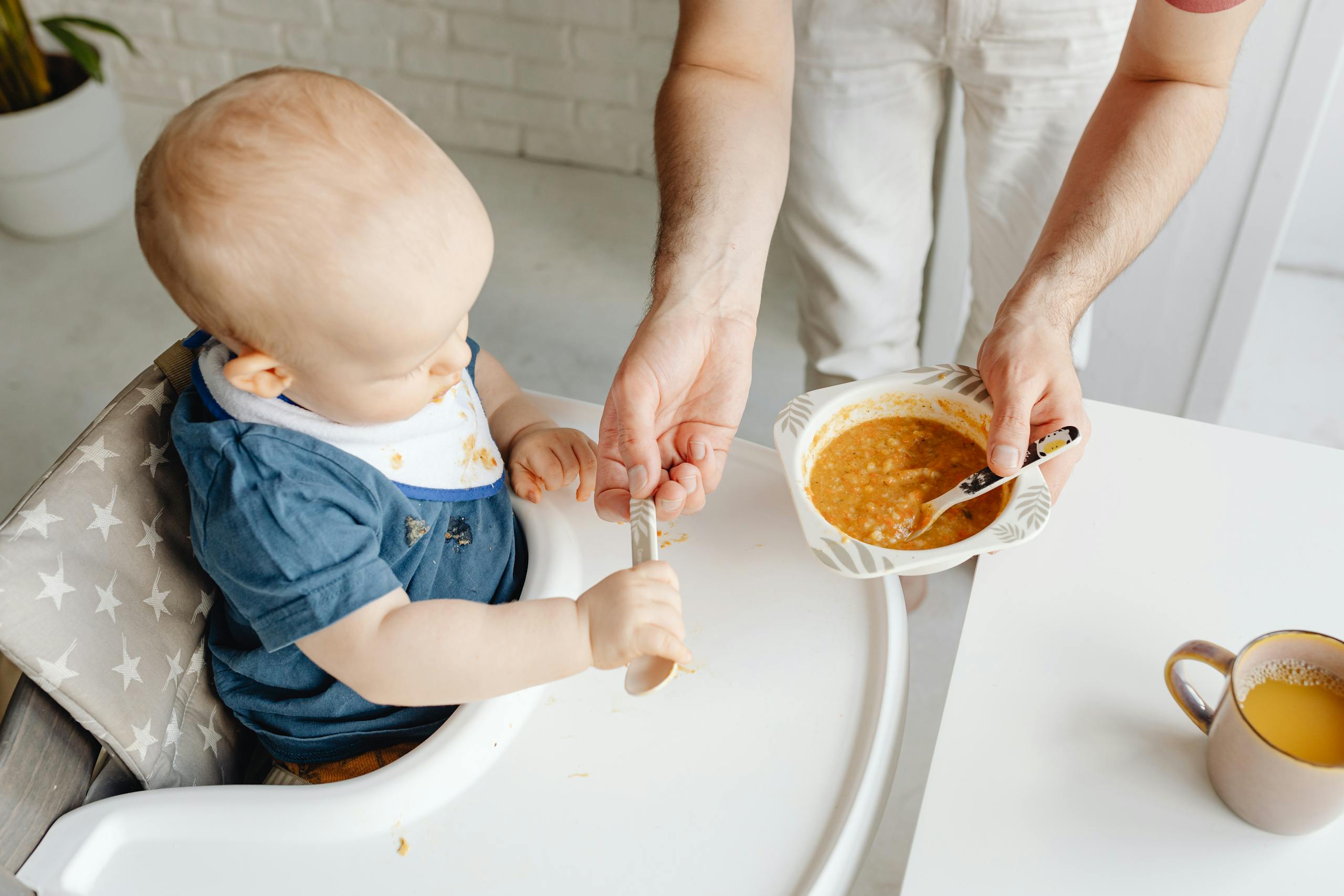
Disclaimer: The information provided in this section is for general informational purposes only and is not intended as medical advice. Always consult with your own doctor or your child’s pediatrician before making any changes to your diet or your child’s diet/feeding approach. Read the full disclaimer here.
One of my favorite parts of being a pediatrician is talking with parents about starting solids. It’s such an exciting milestone – but it can also be kinda overwhelming!
In this post, I’m sharing some tips for starting solids for babies – from the perfect first foods to how much you should give and more! I get tons of great questions from parents during well visits related to starting solids, so I thought I’d frame this post as a FAQ and answer the most common questions I get.
If you’re looking for a list of the best first foods for babies, check out this post featuring top 20 of my recommend first foods for babies!
So with that short and sweet introduction out of the way, let’s get started!
PS: These are general tips & recommendations based on my personal experience, and should not be seen as medical advice for your child. It’s important to discuss starting solids with your baby’s pediatrician first before starting, and to ask any questions you have about feeding difficulties, growth concerns, or nutrition concerns.
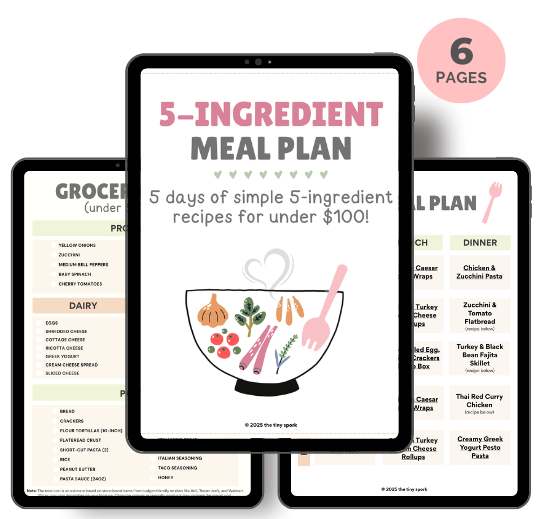
make 15 MEALS for UNDER $100
(FREE 5-Day Meal Plan!)
Too tired to meal plan — but can’t afford takeout again? Sign up for my email list and I’ll send you a FREE 5-day meal plan with easy 5-ingredient recipes, a printable grocery list, blank meal planner, and exclusive recipes 🙌🏽
Disclaimer: The information provided in this section is for general informational purposes only and is not intended as medical advice. Always consult with your own doctor or your child’s pediatrician before making any changes to your diet or your child’s diet/feeding approach. Read the full disclaimer here.
1. When should I start solids?
The true answer is that it depends! The timing of when your baby can start start solids depends on your baby’s development and if they are showing signs of readiness. It’s important to talk to your baby’s pediatrician before starting solids to make sure your baby is developmentally ready to begin.
Most babies are ready to start solids by 6 months of age, but some babies may demonstrate readiness by 4-5 months of age. Babies who were born prematurely should wait until they get approval from their pediatrician to begin solids.
2. What are the signs my baby is ready?
- Sitting up with support
- Good head and neck control
- Interest in what you’re eating (reaching, watching, opening mouth)
- Losing the tongue-thrust reflex (not pushing food out with their tongue)
If you are not sure that your baby is meeting these milestones, talk to your pediatrician.
3. Should I start with baby cereal or vegetables/fruits?
There’s no one correct answer to this question, and advice may differ even amongst pediatricians. There is also no one particular food that you need to start with!
I generally recommend starting off with a single-grain iron fortified baby cereal such as oatmeal or barley. This is because (especially breastfed babies) start needing supplemental iron sources around 4-6 months of age, and fortified baby cereal is a good source of iron. Check out this post for a list of iron-rich starter foods, along with 20 other best first foods for babies!
I recommend introducing fruits and vegetables next. I like alternating between a new fruit and a new vegetable to add a variety of different flavors, textures, and nutrients to your baby’s diet. Some parents like to offer all the veggies first before they start introducing fruits, which is also okay.
Make sure that all food is safe in texture (soft and mushy is best). Offer foods one at a time and wait at least 3 days between introducing new foods to monitor for any reactions.
4. What are the best first foods?
Some great first foods when starting solids include:
- Iron-fortified baby oatmeal
- Pureed fruits – banana, applesauce, pears, prunes, avocados, mangos, etc.
- Pureed vegetables – sweet potato, spinach, broccoli, green beans, squash, etc.
- Cooked and pureed lentils
- Cooked and pureed meats
For a complete list of 20 best starter foods and ideas for how to serve them, check out this post!
5. How much and how often do I give solid food?
At the beginning, just offer 1-2 tablespoons once per day. This is just a general number. If your baby wants more or less, it’s okay! It’s more about getting your baby used to the new texture and flavor, rather than how many calories or nutrition they get from it.
Remember, your baby’s main source of nutrition is still breastmilk or formula at this age, and solids are mostly just for learning. Over time, you can increase to 2 meals per day and eventually 3 meals per day around 9-10 months of age.
6. What’s better—traditional feeding with purees or baby-led weaning?
To date, there are no scientific studies that demonstrate if one feeding method is better than the other. The choice of which method you pick depends on your comfort level and preferences. I would recommend that you read about both methods and have a conversation with your baby’s pediatrician to come up with a feeding plan.
I know some parents are terrified at the thought of baby-led weaning and prefer to spoon feed with purees first. A lot of parents do a combination of both and find that it works best for their baby. There really is no one-size-fits-all answer to this question!
If you want to learn more about the basics of baby-led weaning, check out this guide!
7. Is it okay to let my baby play with their food?
Absolutely! Exploring food with their hands is a natural and important part of sensory and motor development for babies. It’s totally normal for most of the food to end up on their face, bib, or on the floor. It might be messy, but it’s how babies learn about texture and taste. Keep a wipe nearby and let them dig in!
8. What foods should I avoid?
Great question! These are the foods I typically recommend avoiding when starting solids:
- Honey – presents a risk of botulism if given under the age of 1
- Whole milk – babies should drink only breastmilk or formula until the age of 1
- Choking hazards – examples include whole grapes, popcorn, nuts, hot dogs, raw veggies, large chunks of food. Here is a complete list of foods that are choking hazards.
- Added salt or sugar – this includes no juice as well! Don’t add extra salt or sugar to food, but other seasonings & herbs (like garlic powder, basil, thyme, etc) are okay
9. When can I introduce allergens like peanut or egg?
In the past, pediatricians used to recommend waiting until a child was older to start common allergens. However, recent studies show that early introduction of allergens at around 6 months of age can actually help prevent allergies!
High allergen foods include:
- Peanuts
- Tree nuts
- Egg
- Fish
- Shellfish
- Milk products [including yogurt & cheese]
- Soy
- Sesame
- Wheat
The biggest exceptions to this rule is if your baby has moderate-severe eczema or a history of food allergies. Talk to your pediatrician to determine how and when to introduce allergens into your baby’s diet.
Start with small amounts and monitor for reactions. Wait at least 3 days before trying a new food. Also, don’t introduce multiple high-allergen foods at the same time or in close proximity to one another.
10. How do I serve peanut butter safely?
You definitely don’t want to give peanut butter by itself because it’s too thick and can be a choking hazard. Instead, make a peanut butter puree by mixing a small amount (1 teaspoon) of smooth peanut butter with water until it’s thin and runny. You can spoon-feed the puree by itself or mix it into baby oatmeal, mashed banana, or yogurt.
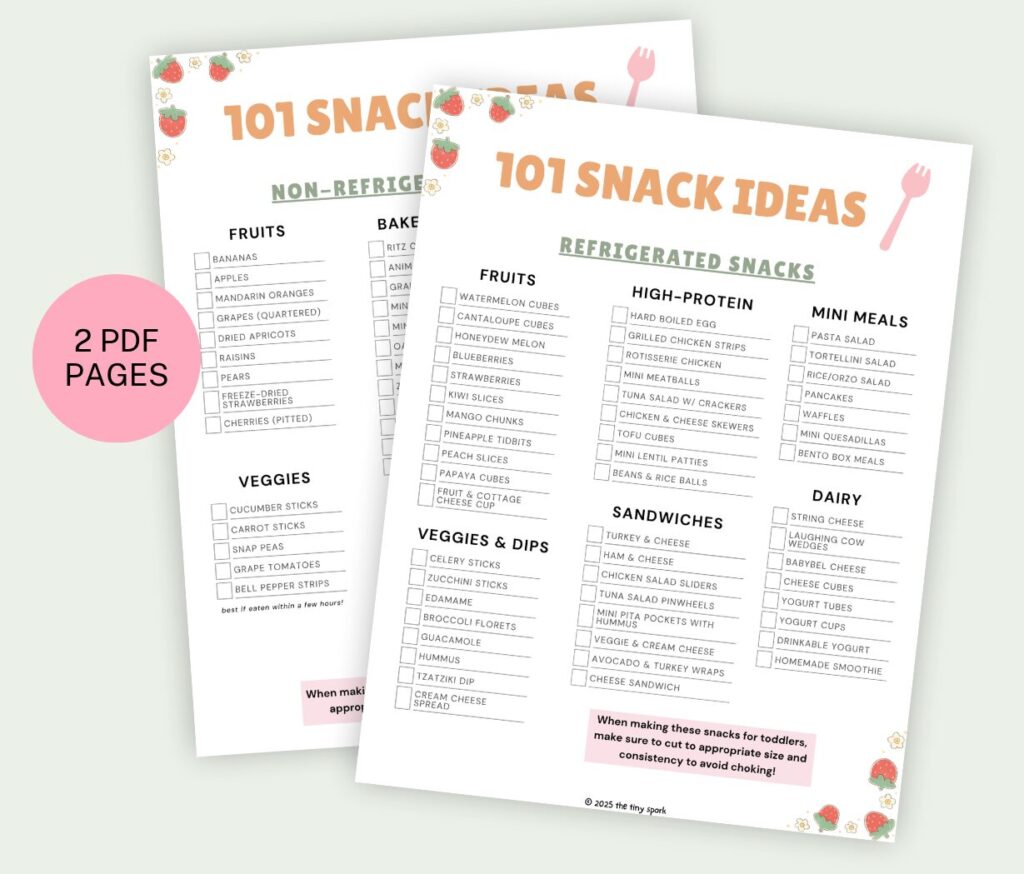
Need snack ideas? 🍿
Sign up for my email list & I’ll send you a FREE printable list of 101 snack ideas!
11. My baby made a face—does that mean they don’t like it?
Not necessarily! Babies make faces when tasting new flavors and textures—that’s totally normal when starting solids. It can take 10–15 tries before a baby accepts a new food. Keep offering it in different ways without pressure.
12. How do I prevent choking?
Always supervise your baby while eating, offer age-appropriate textures, and avoid foods that are considered choking hazards (whole grapes, popcorn, nuts, hot dogs, raw veggies, large chunks of food, etc).
Babies should be sitting completely upright in a high chair when being fed, not reclining or walking around. Consider taking an infant CPR class if you haven’t already—just in case!
13. What’s the difference between gagging and choking?
Gagging is a protective reflex and is common when babies are learning to eat. I know it can still be very scary for many parents! It usually manifests as coughing or retching during feeds.
Choking is silent and dangerous—there’s no sound, and the baby may appear panicked or turn blue. If you’re not sure, it’s always better to be safe than sorry and seek medical help immediately.
I highly recommend reading this short handout from Boston Children’s to learn more.
14. When and how do I introduce water?
You can introduce small sips of water in an open cup or sippy cup starting at 6 months of age. Water is not a substitute for breastmilk or formula but can help babies learn to drink and stay hydrated when starting solids. Talk to your pediatrician about the right amount of water for your baby, but I generally recommend no more than 4-8oz per day.
There are many different types of cups you can try – open cup, sippy cup, straw cup, 360 cups – with many different opinions on which one is the best. Some speech-language pathologists recommend against the use of sippy cups due to interference with oral development.
There are no scientific studies done on this topic, to my knowledge, so I usually recommend parents try different cups and see which one works best for their child. However, I do think that giving water in an open cup (with assistance of course!) is ideal and the most “natural” way of offering liquids to your child.
15. Can I make my own baby food?
Yes! I generally recommend parents make their own baby food at home when possible since it’s fresher and more cost effective. Plus, it doesn’t require a ton of work – you can steam & mash soft fruits and vegetables, or use a blender to create smooth purees. You can even meal prep to save time!
16. How often should I offer new foods?
I recommend waiting at least 3 days between introducing new foods. This is to monitor for any adverse or allergic reactions that may occur, and allows you to gradually expose your child to a variety of flavors, textures, and nutrients.
17. What do I do if my baby doesn’t like solids?
Some babies may struggle with accepting solids initially – which is normal! Keep offering solids without pressure at least once or twice per day, and don’t force feed. Try different textures, temperatures, and presentations. If your baby consistently refuses food, talk to your pediatrician for more guidance.
18. When can I introduce finger foods?
Finger foods are foods that babies can pick up and eat by themselves. If you’re following the traditional method of infant feeding, finger foods are generally introduced around 8-9 months of age. Parents following baby-led weaning often introduce soft finger foods as early as 6 months of age.
Make sure foods are cut to the appropriate size. For babies 6-9 months of age, cut the food into long strips or wedges, which are easier for young babies to grasp. For babies 9-12 months of age, you can make the pieces slightly smaller and more bite-sized.
Also, make sure the foods are very soft – a good way to check is by pressing on the food with your fingers or a fork and making sure it “mushes” up easily with gentle pressure.
This is a great visual example of proper finger food size by age!
Image source + credit: Thriving Nest
19. How do I include iron-rich foods?
Some iron-rich foods that are safe for babies include:
- Iron-fortified cereals (like oatmeal & barley)
- Meats (chicken, beef, turkey)
- Fish (especially salmon)
- Lentils and beans
- Tofu
- Eggs
- Green leafy vegetables (like spinach)
For the ones that are considered high-allergens – like fish, eggs, and tofu (due to soy) – make sure you speak with your baby’s pediatrician first.
20. What’s the goal with solids by 12 months?
I love this question! By 12 months of age, most babies should be eating a variety of table foods and finger foods, with less of an emphasis on pureed food. I also usually recommend babies eat 3 meals/day and 1-2 snacks/day by this age.
Again, this is just a general rule of thumb. The answer to this question will also depend on your baby’s development, whether they were born prematurely, and when they started solids.
I hope you found this information helpful in starting solids for babies! Be sure to check out my other blog posts for more infant feeding guidance. Don’t forget to check out this post featuring the 20 first foods I recommend for babies! Happy feeding!
Don’t forget to pin this post for later!


